
MONDAY, Aug. 1 (HealthDay News) — For many patients, biopsies of lung nodules found during CT scans may be unnecessary and even dangerous, a new study finds.
“As we have been doing more CT scans, we are finding more of these nodules or spots in the lungs, which have unclear clinical significance,” said lead researcher Dr. Renda Soylemez Wiener, an assistant professor of medicine at Boston University School of Medicine.
Nodules are spotted in as many as 25 percent of patients undergoing a chest CT scan, the study said. “When nodules show up, doctors and patients need to decide whether to biopsy that spot in the lung,” she said. “There are risks to that [surgical] procedure, which may be more common than most people realize.”
Lung collapse and bleeding are complications of the procedure, which involves removing and examining a sample of tissue.
Wiener, noting that 98 percent of the nodules turn out to be benign, said physicians perform too many unnecessary lung biopsies.
Too many CT scans are also done, Wiener said. “We find information we don’t know what to do with. Like we find a spot in the lung and have to decide whether or not to expose a patient to the risk of biopsy,” she said.
One factor driving lung biopsies is physician fear of being sued for not finding a cancer, Wiener said. Also, a recent U.S. National Cancer Institute report, which found that CT screening reduced lung cancer deaths compared with use of traditional chest X-rays, is expected to boost the use of scans for smokers and others at risk of lung cancer. But doctors need to tell patients about the risks, the study authors said.
“There are situations where it might not be worth it to do a biopsy,” Wiener said. These include “people with either very low risk of cancer or people who have such a high risk of cancer that they are probably going to go to surgery no matter what a biopsy shows,” she said.
Also, people so frail that they couldn’t withstand lung cancer treatment should not have a biopsy, Wiener said.
For the study, published in the Aug. 2 issue of the Annals of Internal Medicine, Wiener’s team reviewed data on 15,865 adults who underwent a lung biopsy.
Of the 1 percent who experienced bleeding as a result of the procedure, 17.8 percent needed a blood transfusion, they found.
Lung collapse, a condition called a pneumothorax, occurred in 15 percent of the patients.
Of that group, 6.6 percent needed a chest tube to expand the lung and a longer hospital stay. These patients were also more likely to develop respiratory failure that required mechanical ventilation, the researchers found.
Complications during biopsy were more common among older patients, smokers and people with chronic obstructive pulmonary disease, the researchers said.
Dr. Norman H. Edelman, a professor of preventive medicine, internal medicine, physiology and biophysics at Stony Brook University in New York and chief medical officer for the American Lung Association, said the “the findings are especially relevant” in light of the National Cancer Institute lung cancer screening trial.
“In all likelihood, the Institute’s findings will result in the identification of many more pulmonary nodules, which physicians will have to evaluate,” he said.
Typically, doctors must choose between careful watching with subsequent CT scans and early biopsy. “The current report should be helpful to physicians in making a ‘real world’ risk-versus-benefit analysis between the two approaches,” Edelman said.
Edelman also said the regional variation in use of needle lung biopsy invites examination. (The data showed a rate of 14.7 per 100,000 adults in New York compared to 36.2 per 100,000 adults in Florida.)
“If we are to be rational about resource utilization, we must solve the question of whether some regions do too few procedures or other regions do too many,” he said.
More information
For more information on lung cancer, visit the U.S. National Library of Medicine.

